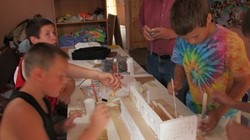Many of us, in looking back at our childhood experiences in Sunday school or vacation Bible school, will remember certain children for whom and explicitly Christian environment was a new and possibly unwelcome experience.
No doubt their parents or grandparents thought the experience would be good for them, and perhaps it was. Nonetheless, the presence of such children does make life interesting for the Sunday school teacher or youth leader involved.
During my time in Russia this past summer, I had the privilege of accompanying the Rev. Jones Doughton and Jim Harbison, from First Presbyterian Church in Columbus, Ga., on a trip to Rzhev, Russia, in order to assist with a vacation Bible camp conducted by the local Baptist church with help from the congregation of Good News Baptist Church in Moscow.
FPC Columbus and Good News Church have a long-standing sister church relationship, and Jones had made two trips to Russia previously. In fact, several years ago, Jones and I worked together at a children’s camp put on by Good News Church just outside of reserve, on the site of one of the major battlefields of the Second World War.
We knew, based on previous conversations with the team from Moscow, that many of the kids in the camp would be coming from families outside the church. In order to reach such children, you have to find a way to hold their attention long enough for them to absorb the spiritual lesson.
Very fortunately for us, Jim has many years of experience as a Sunday school teacher, and brought with him a miraculous teaching aid, namely, a kit from which the kids could build a scale model of the Temple of Solomon in Jerusalem.
Jim made the kit completely from scratch, having calculated all of the necessary proportions from the description of the temple in the Old Testament. We had figurines representing priests and sacrificial animals, altars, lamps, and a great many stones. Jim also brought a collection of paints so that the finished temple and its contents would look realistic.
In addition to the model temple, Jones and Jim brought a number of other, more traditional, craft projects. We left the question of assigning kids to the various projects to our Russian hosts, who chose to have the boys work on the temple while the girls worked on other projects. For the most part, the kids accepted this division of labor without complaint although we did have one or two girls who insisted on working with us.
We had only four days to complete the entire project, including preliminary sanding, assembly, gluing and painting. On the first day, some of the boys, particularly on the older ones, seemed to get bored and disappeared at every opportunity to go and kick a soccer ball.
Given the tight time schedule, we were concerned, but on the second day attendance and participation were much better, and stayed better for the duration of the project. In fact, by the end, we had more people around our worktable then we could accommodate.
Throughout the four days, I was amazed by the extent to which the project seized and held the attention of some otherwise rather rowdy young men, and by Jim’s gentle patience in dealing with them and with the fluidity of all Russian schedules.
It is entirely possible that these young men have already forgotten some of the Bible verses that they memorized during the camp, but they will remember Solomon’s Temple, and the man who made it possible for them to build a model of it.
Rzhev is not a particularly prosperous place, even by Russian standards, and the church there has limited financial resources, which is one of the reasons for their partnership with Good News Church in Moscow, which provided most of the staff for the camp. Additional financial resources were contributed by FPC Columbus.
However, my contributions, in terms of translation and support, and Ellen’s work in coordinating the twinning project, are made possible by the churches and individuals who contribute to the cost of keeping us on the field, our transportation to and from Russia, and the other costs connected with our work.
If you are already contributing, please accept our thanks. If you are not already contributing, please consider doing so if you are able. Finally, regardless of whether you are able to make a financial contribution, please support us with your prayers.
Alan Smith and his wife, Ellen, facilitate a congregational twinning program, pairing U.S. Presbyterian congregations with congregations in Russia. Al’s primary duties relate to the ministries of PC(USA) partners among minority groups in Russia. He also works with refugees from Africa and Asia who have come to Russia in recent years.
To visit the web pages of all Presbyterian Church (U.S.A.) mission workers, visit Mission Connections.

